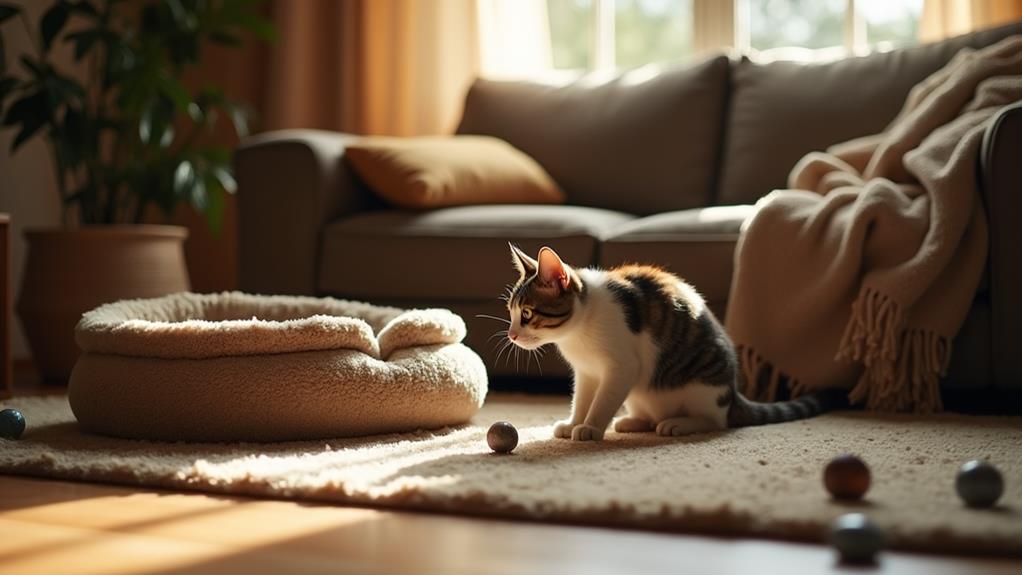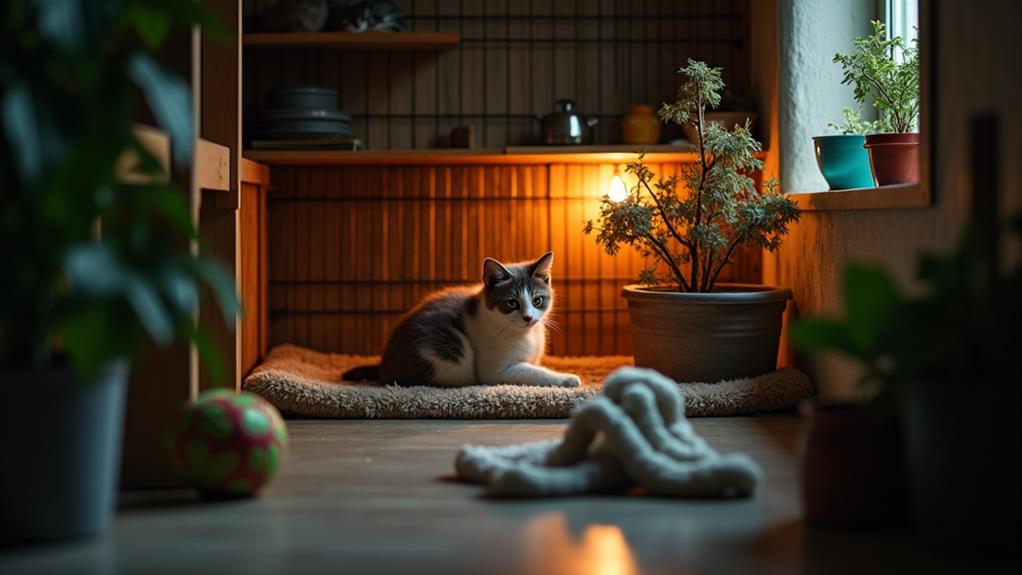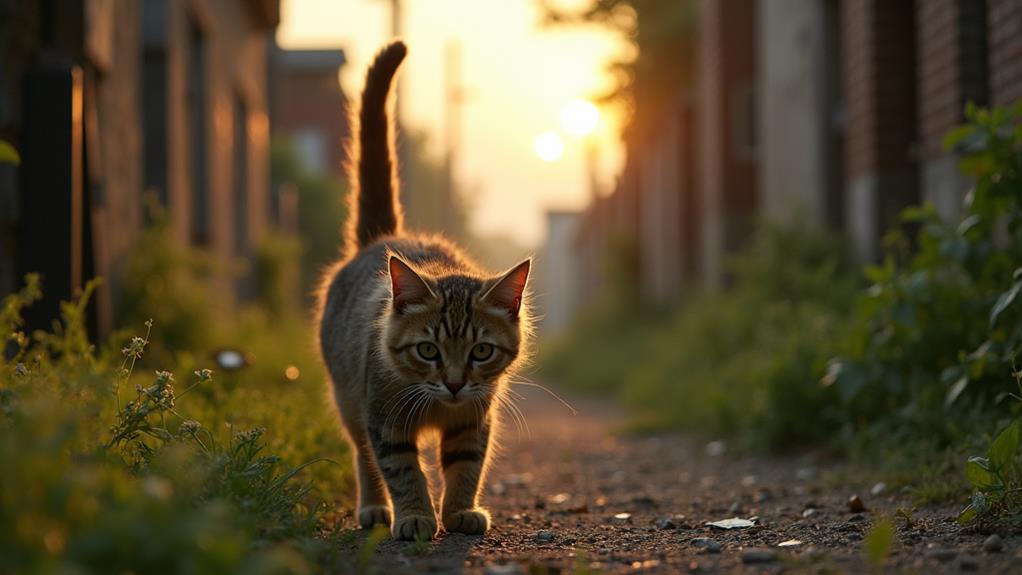How to Help a Feral Cat Adjust to a New Home: Transition Tips
To help a feral cat adjust to your home, start by creating a safe, quiet space with necessities like food, water, and a litter box. Introduce cozy hiding spots and spend time in the area to build trust, using soft voices and indirect gazes. Establish a consistent feeding schedule and engage in regular play sessions for stability. Encourage interactions by allowing the cat to initiate contact and using treats for positive reinforcement. Monitor behavioral changes for signs of comfort and confidence. Patience is key, as building mutual trust may take weeks. More insights await to ease this change.
Prepare a Safe Environment
Creating a safe environment is vital when helping a feral cat adjust to a new home. Start by designating a quiet room equipped with everything a feral cat needs, like scratching posts, toys, food, water, and a litter box. This setup not only guarantees they have access to necessities but also helps them feel comfortable in their new surroundings. Position the food and water at one end of the room while placing the litter box at the opposite end. This strategic placement encourages the cat to investigate its environment without feeling overwhelmed.
Incorporate small hiding spots, such as cat houses or draped blankets, within the room. These secure areas provide the cat with safe retreats when feeling stressed or anxious. Make certain these hiding spots are easily accessible and not located in places where the cat might feel trapped. Spending time in this designated area daily is vital. It allows the cat to gradually acclimate to your presence and begin building trust in a safe setting. By creating such an environment, you're helping the feral cat not only adjust but also feel more comfortable and secure in its new home.
Establish a Feeding Routine
Once you've set up a safe environment, it's essential to establish a feeding routine that offers the feral cat predictability and security. Providing meals at the same times each day helps create a structured environment where the cat feels more at ease. Consistency is key, as it helps the cat associate mealtime with safety and nourishment, reducing anxiety in their new surroundings.
Start by offering high-quality cat food, which can entice the feral cat to eat and form positive associations with their new home. Quality food not only meets nutritional needs but also serves as a motivator for the cat to come out and investigate. During mealtime, sit quietly in the room. Your calm presence can foster a feeling of trust, as the cat begins to connect you with their feeding time.
Avoid interrupting the cat while they eat, as this reinforces their sense of security. Let them enjoy their meal without feeling threatened. Gradually, you can introduce special treats to make mealtime even more rewarding. This encourages the cat to engage with its new environment, turning feeding time into an opportunity for positive interactions and further adjustment.
Minimize Eye Contact

Avoid direct eye contact with a feral cat, as it can be perceived as a threat and heighten their anxiety. Feral cats are naturally wary of human behavior, and staring directly into their eyes might make them feel unsafe in their new environment. Instead, use subtle signals to communicate that you're not a threat. Try slow blinking while occasionally turning your head away. This shows a non-aggressive demeanor and can help the cat feel more secure.
Indirect gazes are comforting for feral cats, allowing them to adapt to your presence without pressure. When you avoid direct eye contact, you create a space where the cat can relax and observe you at their own pace. Let them initiate interaction when they're ready. This approach fosters trust and encourages the cat to approach without feeling cornered or threatened.
Respecting a feral cat's discomfort with eye contact is crucial in building a safe and supportive atmosphere during their adjustment. By understanding and adapting to their needs, you're helping them gradually acclimate and feel safe in their new home. Remember, patience and gentle interaction are key to gaining their trust over time.
Foster Gradual Interaction
Building trust with a feral cat involves more than respecting their need for minimal eye contact; it also means fostering gradual interaction at their own pace. Allow the cat to initiate contact, ensuring she feels safe and unpressured. Trust is built when you respect her space, encouraging her to approach you on her own terms. Begin slowly by using food as a bridge for interaction. Place some treats on your fingers, creating positive associations with touch. This encourages the cat to come closer without feeling threatened.
Another gentle approach is extending a closed fist toward the cat. This gesture is non-threatening and offers an invitation for her to engage. If she sniffs or rubs against your hand, it's a small yet significant step toward trust. Avoid forcing physical contact, as this can damage the progress made. Instead, celebrate every little interaction as progress.
Remember these tips to foster interaction with feral cats:
- Let the cat make the initial move.
- Use food to create positive associations.
- Extend a closed fist as an invitation.
- Never force physical contact.
- Celebrate small successes to build trust.
These steps can help nurture a trusting relationship.
Practice Patience and Understanding

Embracing patience and understanding is key when welcoming a feral cat into your home. It's essential to recognize the change process can take weeks or even months. Don't rush it; practice patience. Semi-feral cats, in particular, may be very guarded, needing space to investigate and adapt at their own pace. This means allowing them to examine their surroundings without forcing interaction. Your primary goal should be to create a non-threatening atmosphere where the cat can feel safe.
Building trust is not instantaneous. Initially, the cat might display fearful behaviors, but over time, with consistent and gentle care, they'll gradually become more comfortable. Remember, each cat is unique, so observe their current socialization stage. This will guide your interactions and help you determine how much they're willing to accept human companionship. Some cats may require more time than others to reach this level of comfort.
Approach this voyage with an open heart and mind. By understanding the cat's needs and allowing them the freedom to progress naturally, you'll foster a bond that's built on mutual trust and respect. This patience will pave the way for a rewarding and lasting relationship.
Monitor Behavioral Changes
As you welcome a feral cat into your home, closely monitoring its behavioral changes is vital. Pay attention to signs of comfort, like lounging and playing in your presence. These behaviors indicate that your cat is beginning to feel safe. Keep an eye on its feeding habits too; regular and relaxed eating shows successful adaptation. It's important to watch for any indicators of stress, such as hiding, excessive grooming, or vocalizations. These signs might mean your cat needs extra comfort and reassurance.
By tracking exploration patterns, you can gauge their confidence. If your cat spends more time outside of its hiding spots, it's a positive sign. Document changes in social interactions as well. A cat that's more open to human presence is building trust, showing progress in adjusting to its new environment.
Here's a quick checklist to help you monitor your feral cat's behavior effectively:
- Look for lounging or playing as signs of comfort.
- Observe regular feeding habits to confirm adaptation.
- Notice hiding or excessive grooming as stress indicators.
- Track exploration patterns for signs of confidence.
- Document social interaction changes to assess trust building.
Encourage Exploration and Comfort

When welcoming a feral cat into your home, it is essential to encourage investigation and comfort. To help your feral friend adjust, create a safe space with scratching posts, toys, delicious food, water, and a litter box. Make sure the litter box is placed away from the food to keep her comfortable. Encouraging investigation starts with providing positive experiences. Use special treats to coax her out of hiding spots, helping her form positive associations with new areas of your home.
Spend time in the room with her, speaking softly and tossing treats to help her associate your presence with safety and comfort. This routine will help her feel safe and secure. Avoid direct eye contact and use indirect gazes, as this non-threatening behavior can motivate her to explore her surroundings without fear.
Maintaining a consistent routine with feeding and playtime is significant, as stability helps her feel more secure. The more predictable her environment, the more at ease she'll be. With patience and understanding, you'll see her confidence grow, and soon enough, she'll be investigating her new home with curiosity and comfort.




